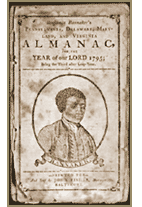







 |
 |
 |
 |
 |
| |
Were all Africans enslaved people?
Not all Africans were enslaved. Throughout the colonial period and all the years after that, some Africans and African Americans (people of African descent who were born in America) were free. Some Africans came here as indentured servants, with contracts like those of the European indentured servants. When their term of service was up, they became free. They would receive wages for their labor. They could buy property, They could marry and raise a family. In Maryland, if they did own property, they could vote in the assembly during the early colonial years when every free man could vote in person in the assembly. No women, regardless of their race, could vote at this time.

Benjamin Banneker, a free African American who lived in Maryland, published an almanac that was read by President Thomas Jefferson
|
One of the men who arrived on the ship Ark with the very first settlers of colonial Maryland was of African descent. His name was Mathias de Sousa. He was an indentured servant. After he served out his term, he became free. He was the skipper of a boat and traded with local Indians. As a free man, he voted in person in the colonial assembly.
A very famous free African American in early Maryland was Benjamin Banneker. He was an inventor and a surveyor. He published an almanac that was read by President Thomas Jefferson. Here is the story of his family. His grandmother, Molly, was an indentured servant who came from England. After she became free, she bought some land and also two enslaved people from Africa to help her with the farm work. Because she knew what it was like not to be free, she freed both Africans. She and one of the men, named Bannaka, were married. They had a daughter, named Mary, who was born free. Mary married a man named Robert, who had been born in West Africa. A very rebellious slave, Robert soon was converted to Christianity and was freed. When Mary and Robert married, he took her last name. Their son (Molly's and Bannaka's grandson) was Benjamin Banneker. He was born a free man and lived in Oella, near Ellicott City.
You can see that slavery and freedom could be complicated. Generally the law said that each child had the status of the mother. If the mother was free, her children were free. If the mother was a slave, her children were enslaved, even if their father was free. Some enslaved people had both African and European ancestors. Although there were many free blacks, most people of African descent were enslaved.
Did all enslaved people live on plantations?
« back to About home
|
|
 |
 |
 |
|
 |
|










